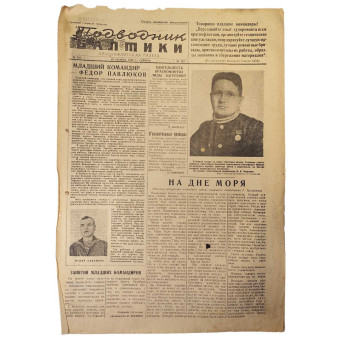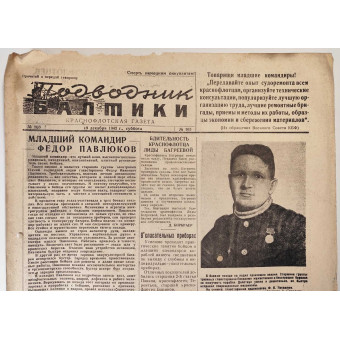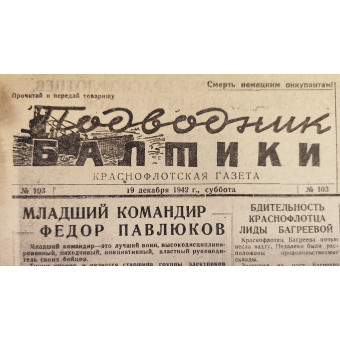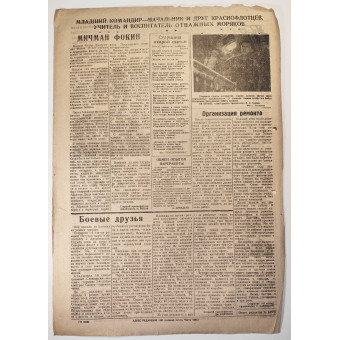Newspaper of the Red Baltic Fleet "Submariners of the Baltic" dated December 19, 1942.
SUBMARINER OF THE BALTIC
RED NAVY NEWSPAPER
No. 103
December 19, 1942, Saturday
Read and pass it on to a comrade!
Death to the German occupiers!
JUNIOR COMMANDER FYODOR PAVLYUKOV
A junior commander is the best warrior—highly disciplined, tactful, initiative-driven, and a true leader of his fighters.
This perfectly describes Senior Guards Sergeant Fyodor Ivanovich Pavlyukov, the leader of an electricians’ team on a submarine. His strictness, high personal discipline, and sense of responsibility make him a respected leader among his subordinates. It is no surprise that his battle group maintains perfect discipline, and their submarine remains in top combat readiness, with all equipment kept in immaculate condition.
VIGILANCE OF RED NAVY SAILOR LYDIA BAGREEVA
Red Navy sailor Lydia Bagreeva was on watch duty near food supply depots.
She noticed a man repeatedly passing by, looking around suspiciously. He acted as if he was inspecting something.
Bagreeva did not take her eyes off him. When he approached the depots again and started examining the locks, she immediately called for a patrol.
L. Birbaev
LIFE-SAVING DEVICES
Training sessions for combat divers continue successfully. These exercises focus on improving their deep-water skills and emergency response techniques under extreme conditions.
All training is supervised by experienced instructors.
G. Siversky
AT THE BOTTOM OF THE SEA
(A story by submarine navigator, Senior Lieutenant G. Kuzmin)
The submarine lay on the seabed at a significant depth. No sound could be heard, only the faint glow of the control panels.
During a night patrol, the submarine suffered damage. Enemy depth charges exploded dangerously close. Water began seeping into one of the compartments. The automatic systems responded instantly, sealing off the flooded section, but part of the crew was trapped inside.
Communication with them was lost. The crew waited anxiously. Immediate action was necessary—any mistake could cost lives.
The commander gathered his officers. A decision was made—surfacing immediately was too risky, as enemy ships could still be nearby. The first priority was damage control.
The mechanics worked swiftly. Pumps were activated, draining the water. Every crew member knew their role.
An hour passed. A signal came from the flooded compartment—communication was restored. The sailors were alive.
By this time, the enemy was no longer a threat. The order was given to surface. The submarine began its ascent. The weight of the water slowly eased off.
Moments later, the crew could see the gray light through the periscope. The sailors, having endured a harsh ordeal, were once again ready for battle.
JUNIOR COMMANDER – A LEADER, A COMRADE TO HIS SAILORS, A TEACHER AND MENTOR OF BRAVE MARINERS
WARRANT OFFICER FOKIN
Warrant Officer Fyodor Dmitrievich Fokin serves on a submarine. Over the years of war, he has participated in numerous combat missions, demonstrating mastery in his role as chief mechanic.
As an experienced specialist, he has trained his subordinates to be just as skilled, disciplined, and courageous as himself.
Warrant Officer Fokin is also actively involved in training junior commanders. Conversations with him always benefit the Red Navy sailors.
Before every mission, he meticulously inspects every system and mechanism. Even while on patrol, he remains constantly vigilant.
During one mission, his submarine attacked an enemy convoy. Fokin personally ensured that all systems were fully operational before the attack. Thanks to his knowledge and skill, the crew had absolute confidence in their submarine’s combat readiness.
SECOND-CLASS PETTY OFFICER
Second-class Petty Officer Ivan Kuznetsov stands watch in the engine room.
Working under extreme conditions, he has proven to be a reliable and disciplined specialist.
During one dive, a technical failure threatened a serious accident. Kuznetsov quickly assessed the situation and took action. Thanks to his prompt response, the submarine avoided major damage.
REPAIR ORGANIZATION
After every training exercise, the crew thoroughly analyzes their performance, identifying weaknesses and developing solutions to improve the technical maintenance of the submarine.
Repairs are carried out so that by the next mission, all systems function flawlessly.
The mechanics' training closely resembles real combat conditions, ensuring that every sailor knows their responsibilities and can handle any mechanical failure in battle.
EXPERIENCE EXCHANGE IN POLITICAL WORK
Meetings among junior commanders continue aboard submarines to exchange best practices.
During these sessions, discussions focus on discipline, enhancing combat readiness, and boosting the morale of Red Navy personnel.
BATTLE COMRADES
They came to the Baltic Fleet from different cities.
Second-class Petty Officer Pyotr Arkadyevich Abramov has served in the Navy since 1936.
Throughout his service, he has faced many challenges. In one mission, his submarine found itself in a dire situation, but thanks to the crew’s teamwork and bravery, they successfully completed their mission and returned to base.
During one patrol, his submarine encountered an enemy minefield. Quickly assessing the danger, Abramov gave precise orders, and thanks to his leadership, the vessel maneuvered to safety.
JUNIOR COMMANDER TRAINING
On the deck of the submarine, training sessions for junior commanders take place whenever weather conditions allow.
Training topics include:
- Tactical maneuvers
- Emergency procedures
- Submarine control during surfacing operations
Second-Class Petty Officer, Order of Lenin, I. Chesnokov
SUBMARINER OF THE BALTIC
RED NAVY NEWSPAPER
No. 103
December 19, 1942, Saturday
Read and pass it on to a comrade!
Death to the German occupiers!
JUNIOR COMMANDER FYODOR PAVLYUKOV
A junior commander is the best warrior—highly disciplined, tactful, initiative-driven, and a true leader of his fighters.
This perfectly describes Senior Guards Sergeant Fyodor Ivanovich Pavlyukov, the leader of an electricians’ team on a submarine. His strictness, high personal discipline, and sense of responsibility make him a respected leader among his subordinates. It is no surprise that his battle group maintains perfect discipline, and their submarine remains in top combat readiness, with all equipment kept in immaculate condition.
VIGILANCE OF RED NAVY SAILOR LYDIA BAGREEVA
Red Navy sailor Lydia Bagreeva was on watch duty near food supply depots.
She noticed a man repeatedly passing by, looking around suspiciously. He acted as if he was inspecting something.
Bagreeva did not take her eyes off him. When he approached the depots again and started examining the locks, she immediately called for a patrol.
L. Birbaev
LIFE-SAVING DEVICES
Training sessions for combat divers continue successfully. These exercises focus on improving their deep-water skills and emergency response techniques under extreme conditions.
All training is supervised by experienced instructors.
G. Siversky
AT THE BOTTOM OF THE SEA
(A story by submarine navigator, Senior Lieutenant G. Kuzmin)
The submarine lay on the seabed at a significant depth. No sound could be heard, only the faint glow of the control panels.
During a night patrol, the submarine suffered damage. Enemy depth charges exploded dangerously close. Water began seeping into one of the compartments. The automatic systems responded instantly, sealing off the flooded section, but part of the crew was trapped inside.
Communication with them was lost. The crew waited anxiously. Immediate action was necessary—any mistake could cost lives.
The commander gathered his officers. A decision was made—surfacing immediately was too risky, as enemy ships could still be nearby. The first priority was damage control.
The mechanics worked swiftly. Pumps were activated, draining the water. Every crew member knew their role.
An hour passed. A signal came from the flooded compartment—communication was restored. The sailors were alive.
By this time, the enemy was no longer a threat. The order was given to surface. The submarine began its ascent. The weight of the water slowly eased off.
Moments later, the crew could see the gray light through the periscope. The sailors, having endured a harsh ordeal, were once again ready for battle.
JUNIOR COMMANDER – A LEADER, A COMRADE TO HIS SAILORS, A TEACHER AND MENTOR OF BRAVE MARINERS
WARRANT OFFICER FOKIN
Warrant Officer Fyodor Dmitrievich Fokin serves on a submarine. Over the years of war, he has participated in numerous combat missions, demonstrating mastery in his role as chief mechanic.
As an experienced specialist, he has trained his subordinates to be just as skilled, disciplined, and courageous as himself.
Warrant Officer Fokin is also actively involved in training junior commanders. Conversations with him always benefit the Red Navy sailors.
Before every mission, he meticulously inspects every system and mechanism. Even while on patrol, he remains constantly vigilant.
During one mission, his submarine attacked an enemy convoy. Fokin personally ensured that all systems were fully operational before the attack. Thanks to his knowledge and skill, the crew had absolute confidence in their submarine’s combat readiness.
SECOND-CLASS PETTY OFFICER
Second-class Petty Officer Ivan Kuznetsov stands watch in the engine room.
Working under extreme conditions, he has proven to be a reliable and disciplined specialist.
During one dive, a technical failure threatened a serious accident. Kuznetsov quickly assessed the situation and took action. Thanks to his prompt response, the submarine avoided major damage.
REPAIR ORGANIZATION
After every training exercise, the crew thoroughly analyzes their performance, identifying weaknesses and developing solutions to improve the technical maintenance of the submarine.
Repairs are carried out so that by the next mission, all systems function flawlessly.
The mechanics' training closely resembles real combat conditions, ensuring that every sailor knows their responsibilities and can handle any mechanical failure in battle.
EXPERIENCE EXCHANGE IN POLITICAL WORK
Meetings among junior commanders continue aboard submarines to exchange best practices.
During these sessions, discussions focus on discipline, enhancing combat readiness, and boosting the morale of Red Navy personnel.
BATTLE COMRADES
They came to the Baltic Fleet from different cities.
Second-class Petty Officer Pyotr Arkadyevich Abramov has served in the Navy since 1936.
Throughout his service, he has faced many challenges. In one mission, his submarine found itself in a dire situation, but thanks to the crew’s teamwork and bravery, they successfully completed their mission and returned to base.
During one patrol, his submarine encountered an enemy minefield. Quickly assessing the danger, Abramov gave precise orders, and thanks to his leadership, the vessel maneuvered to safety.
JUNIOR COMMANDER TRAINING
On the deck of the submarine, training sessions for junior commanders take place whenever weather conditions allow.
Training topics include:
- Tactical maneuvers
- Emergency procedures
- Submarine control during surfacing operations
Second-Class Petty Officer, Order of Lenin, I. Chesnokov





